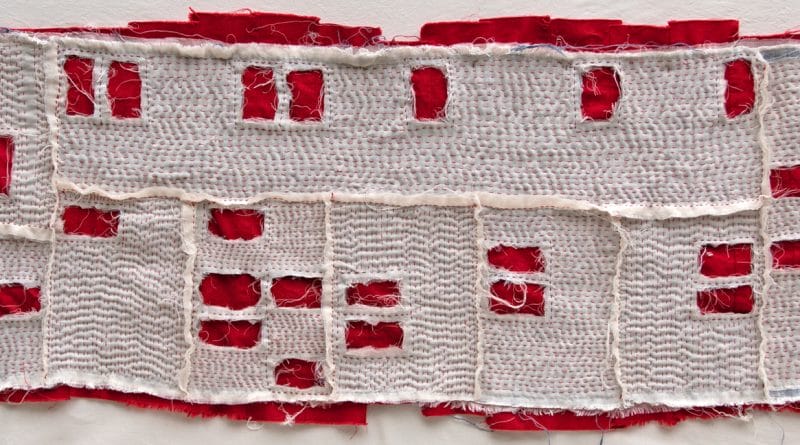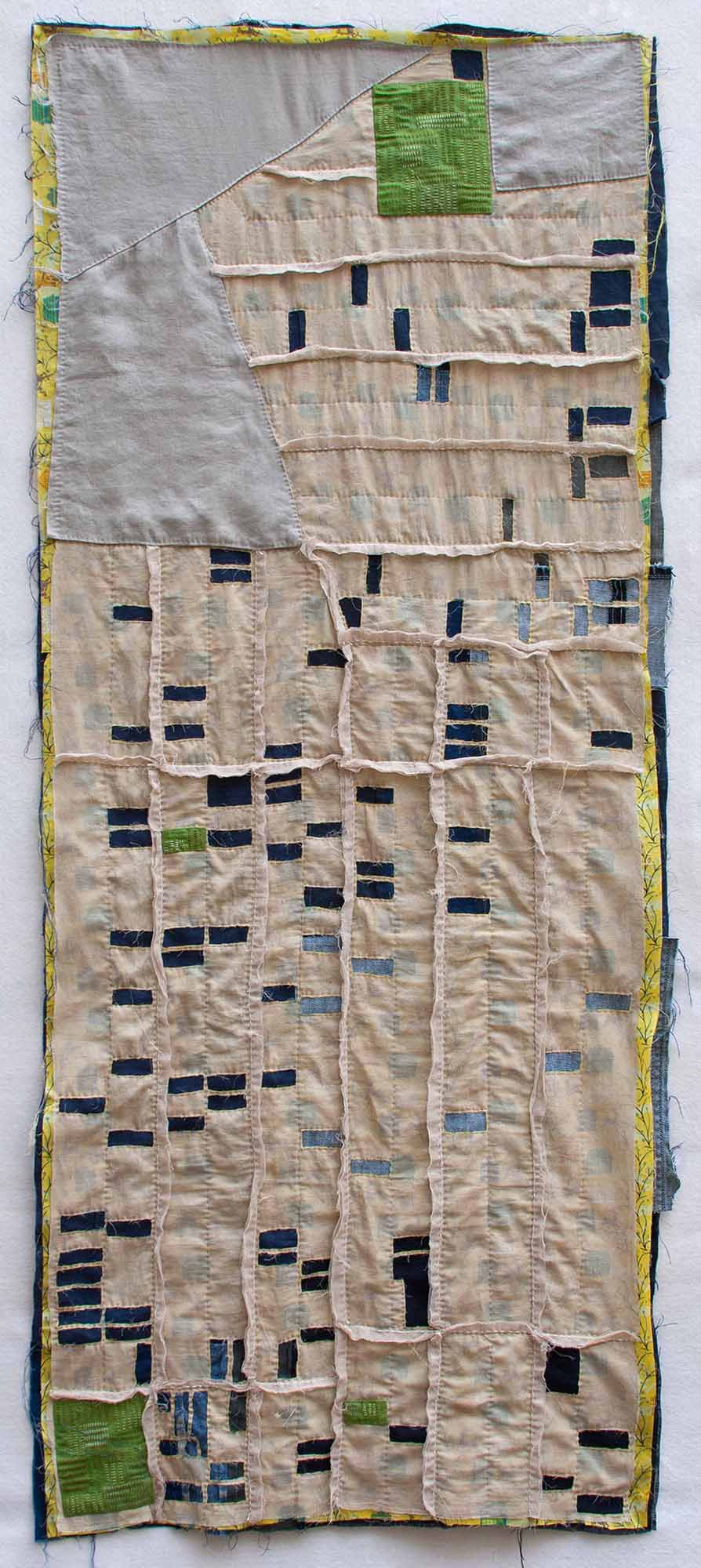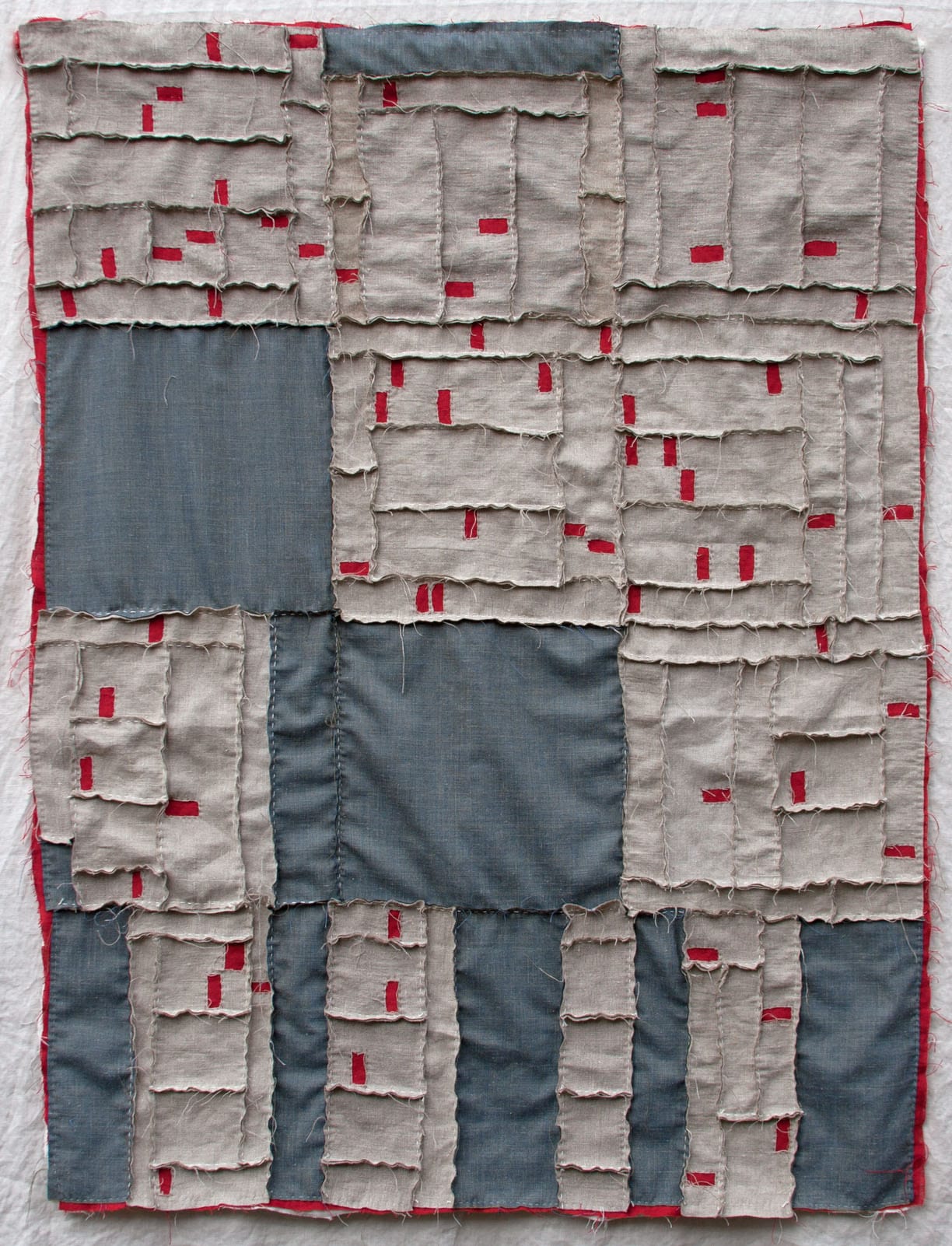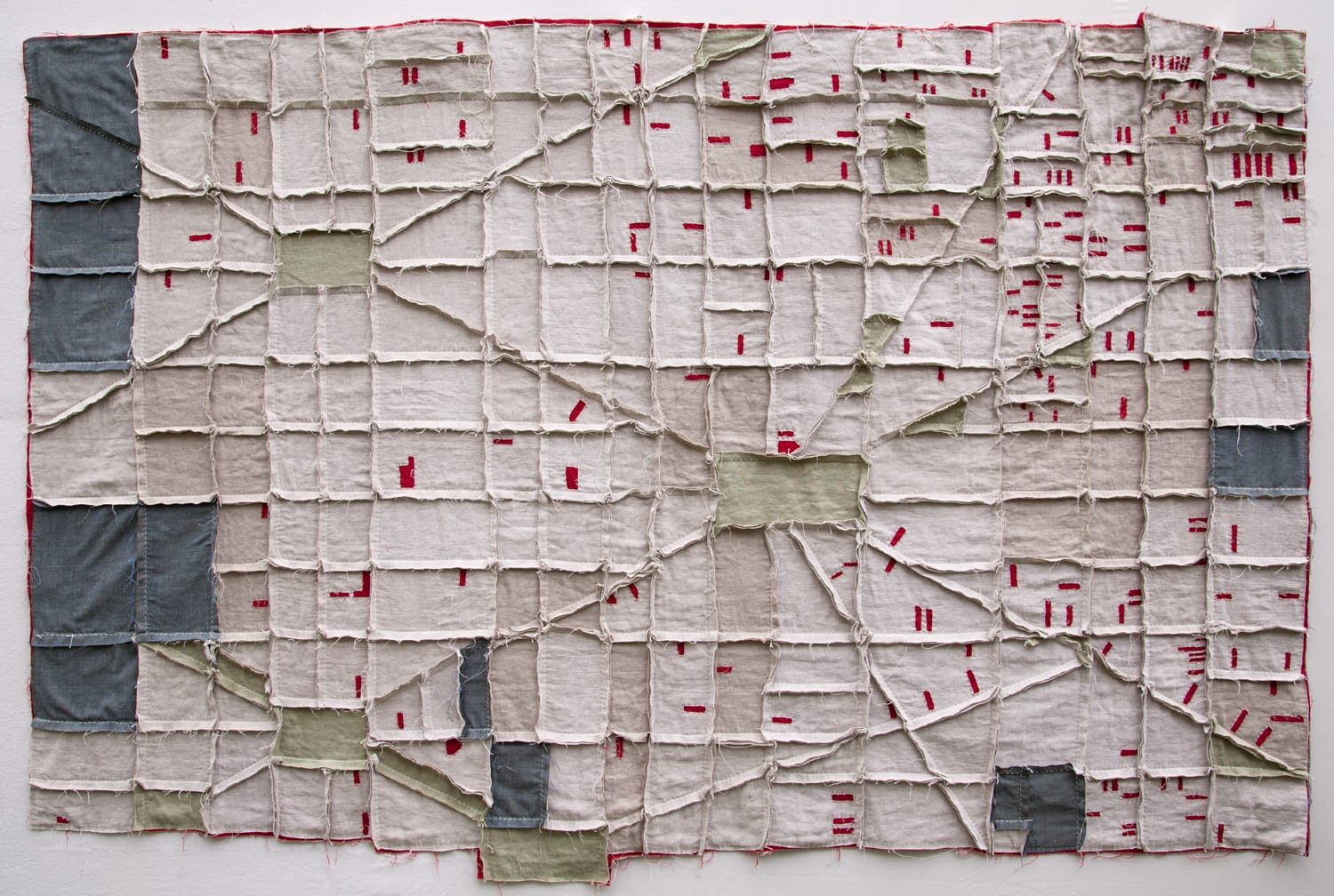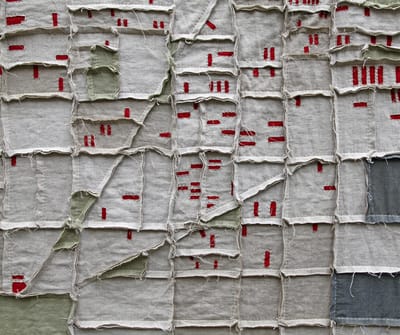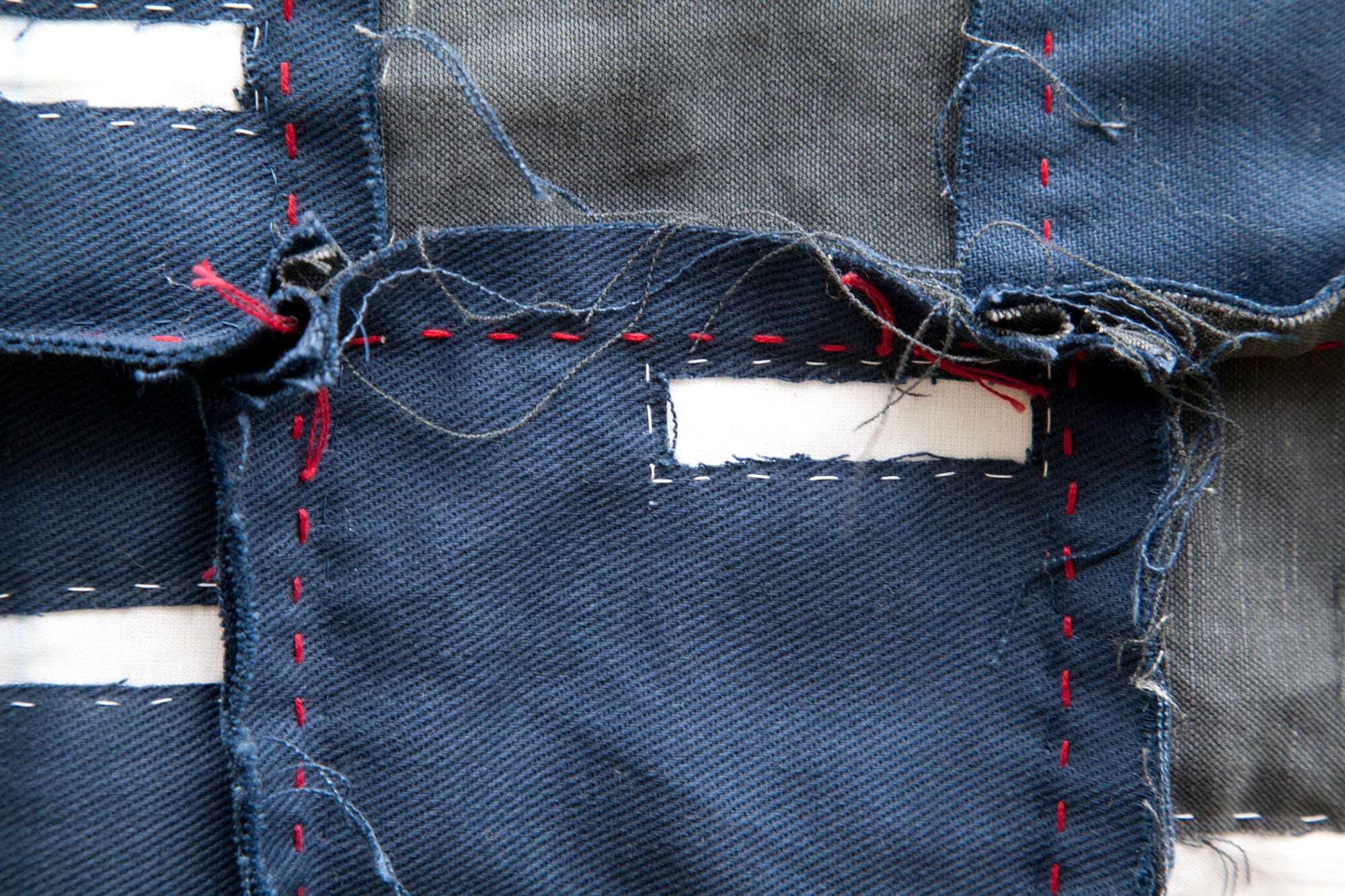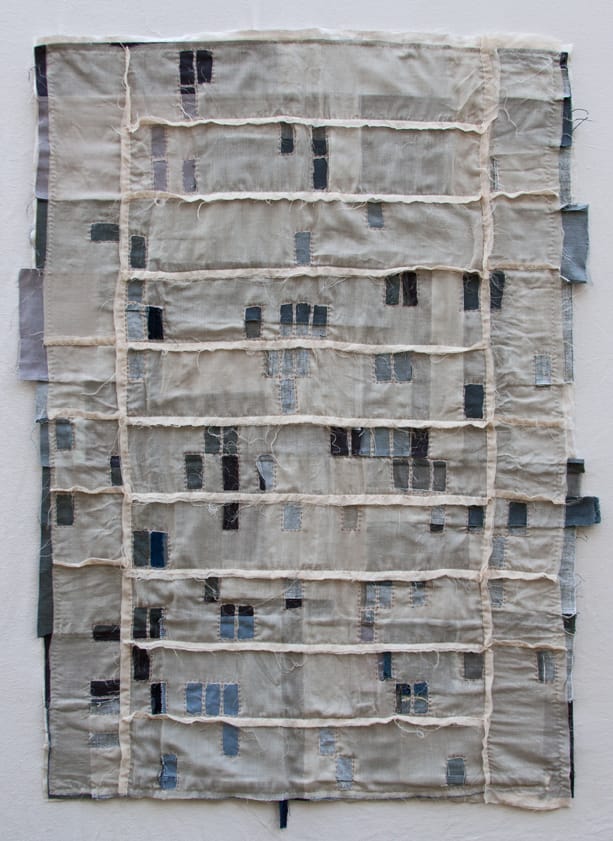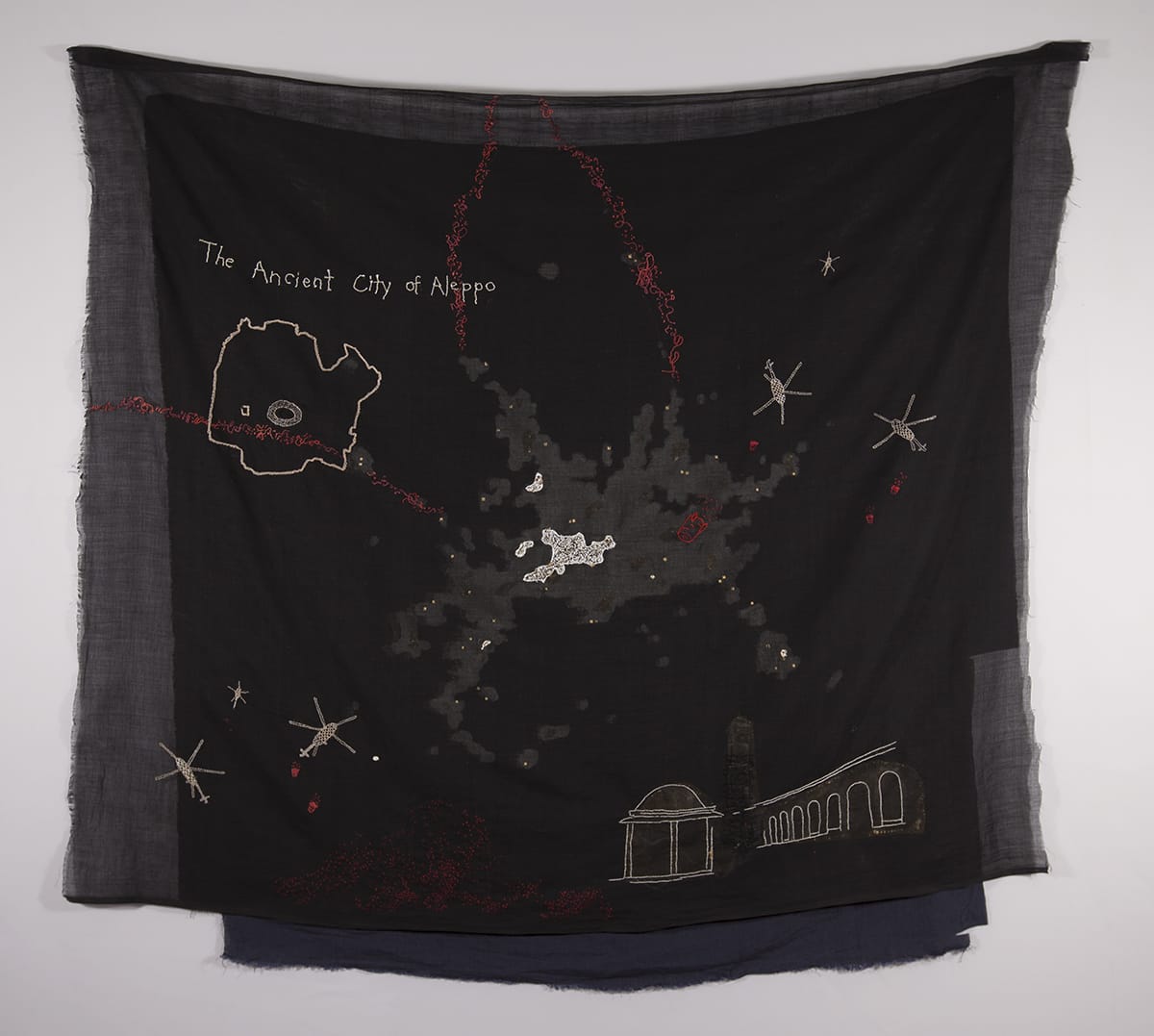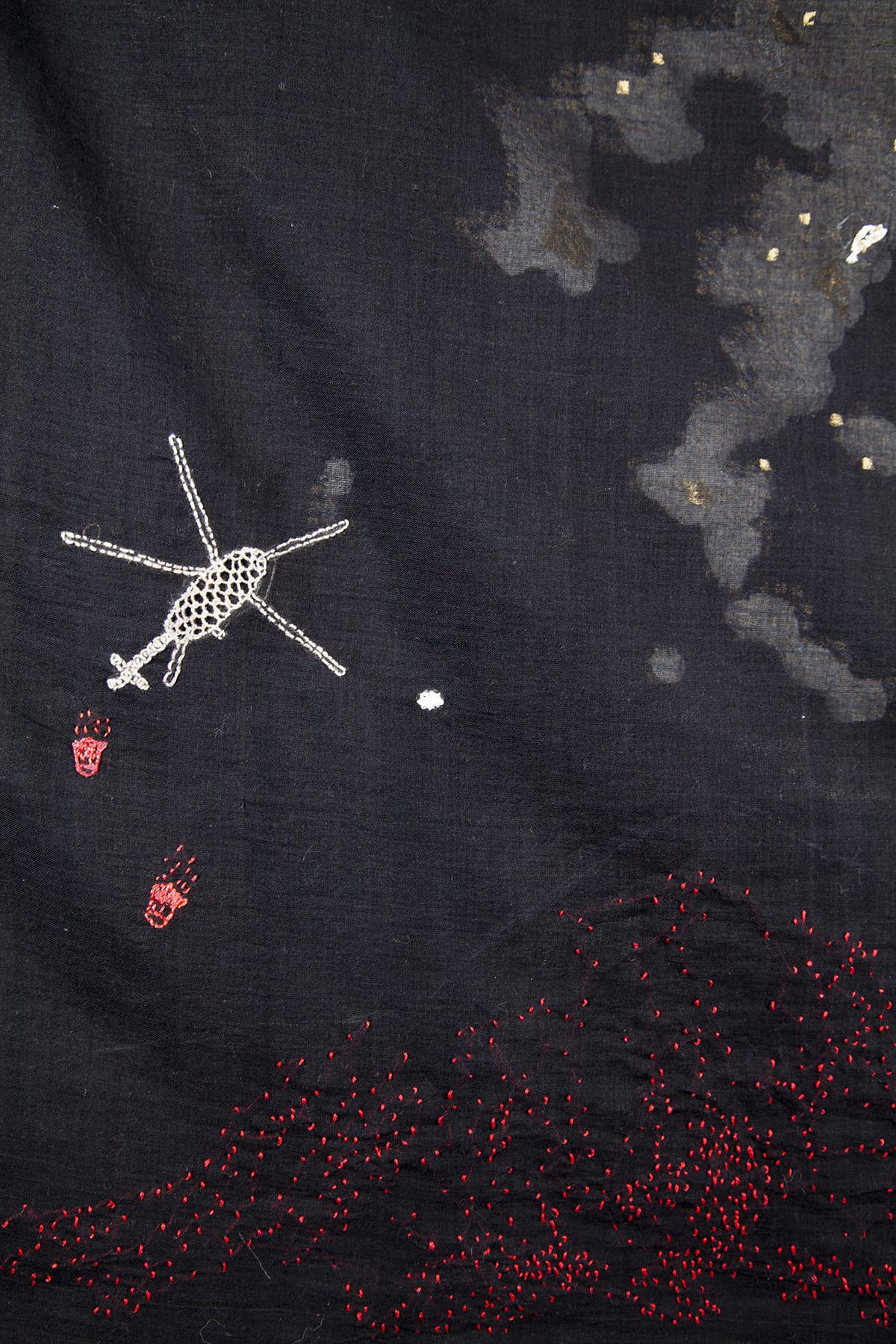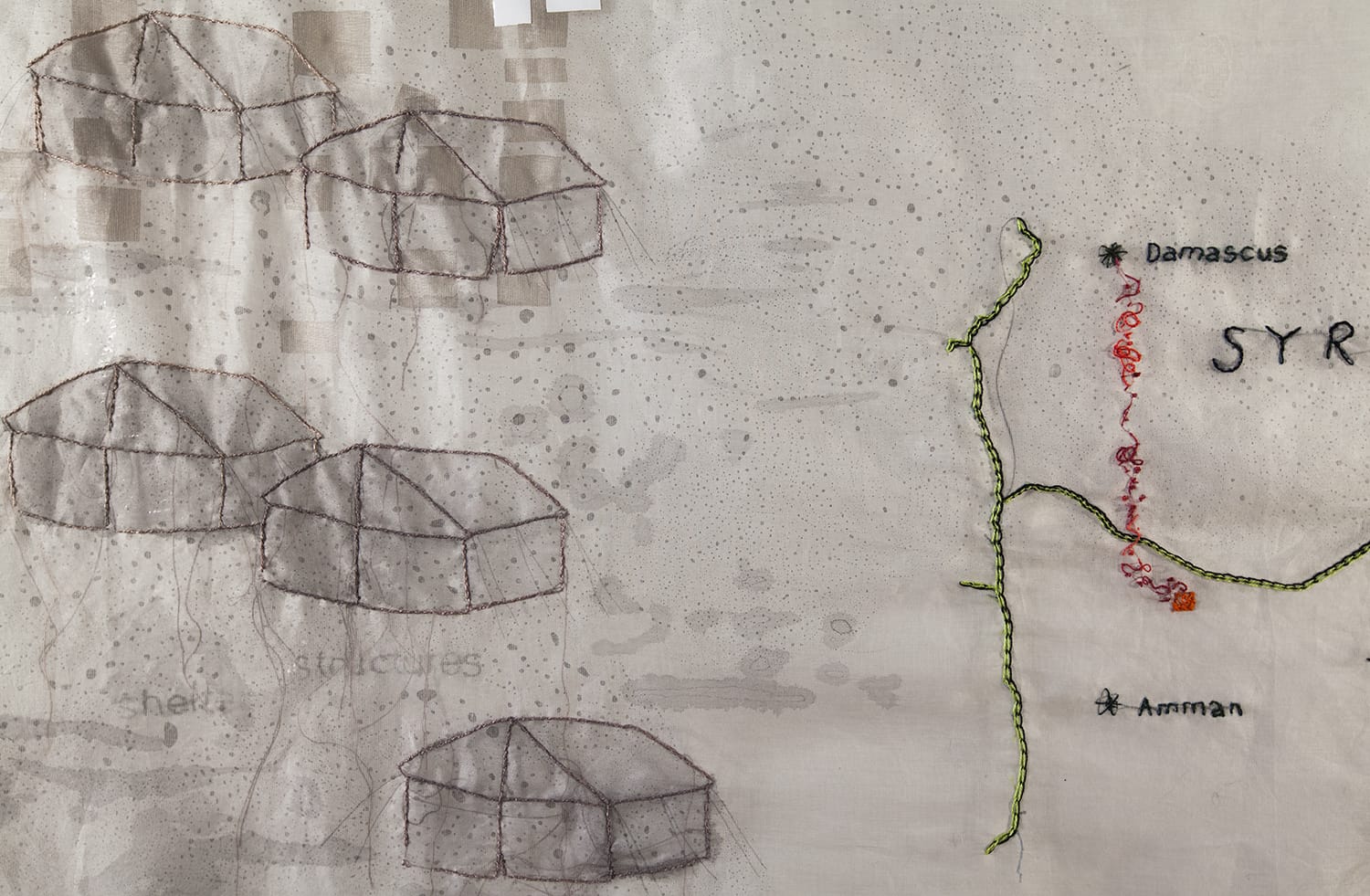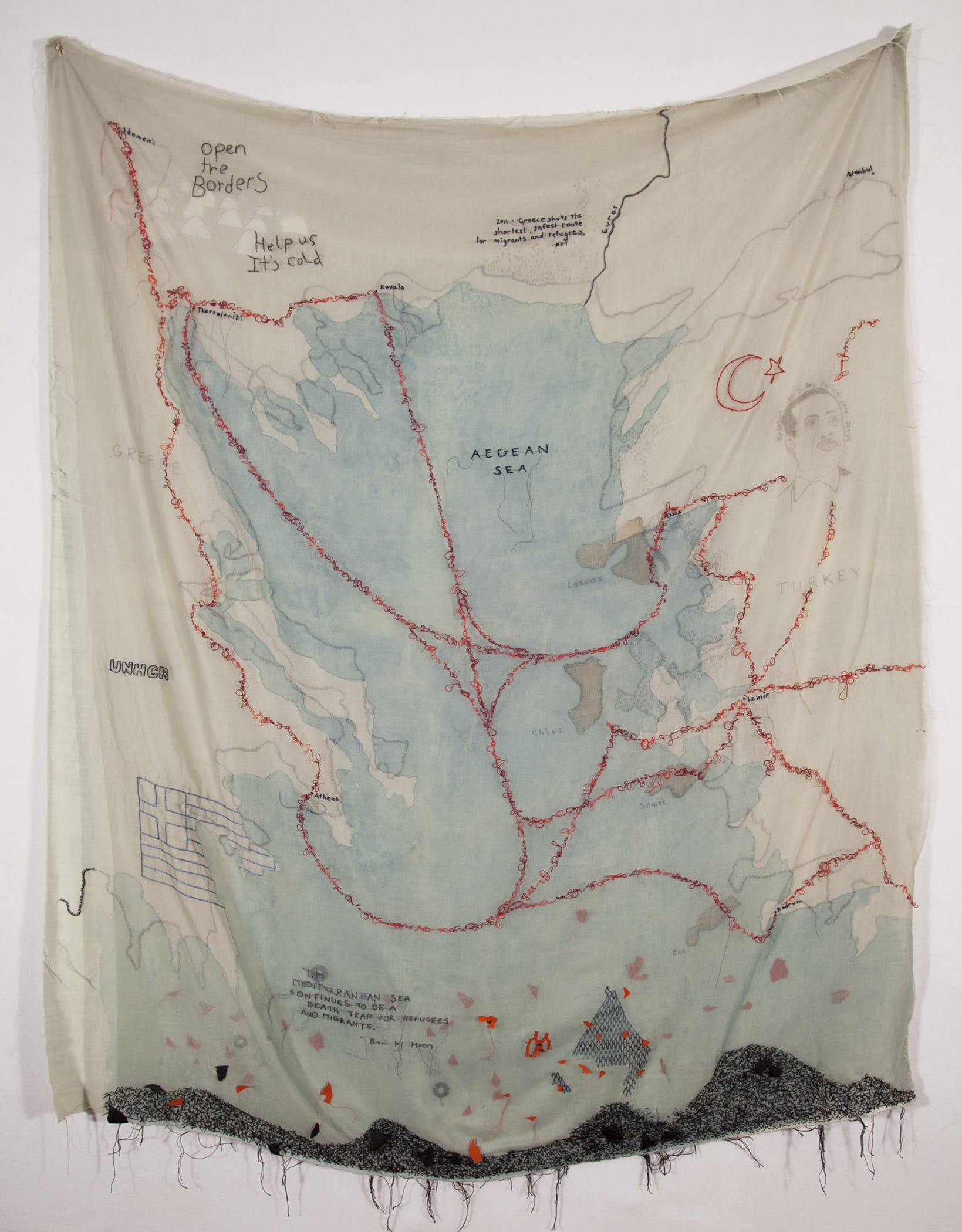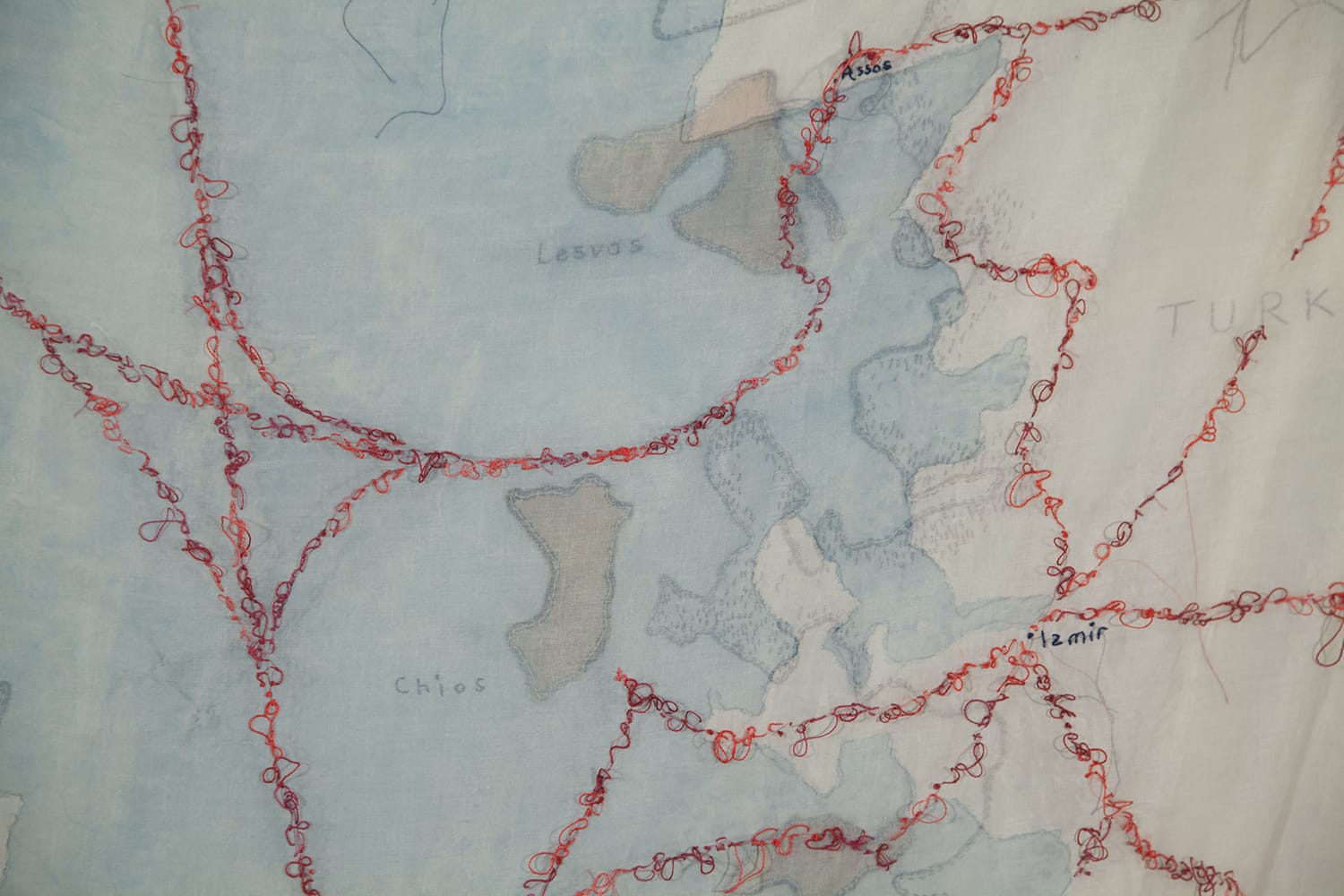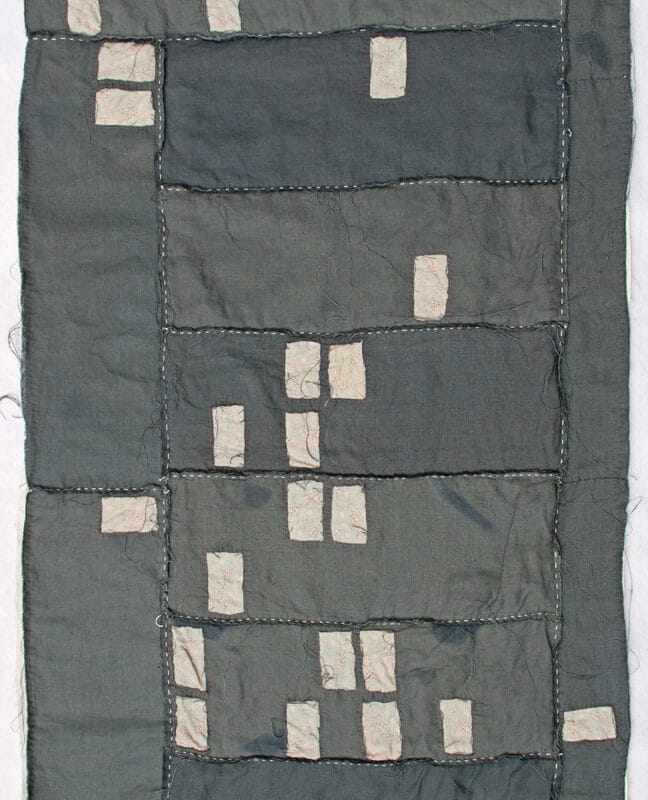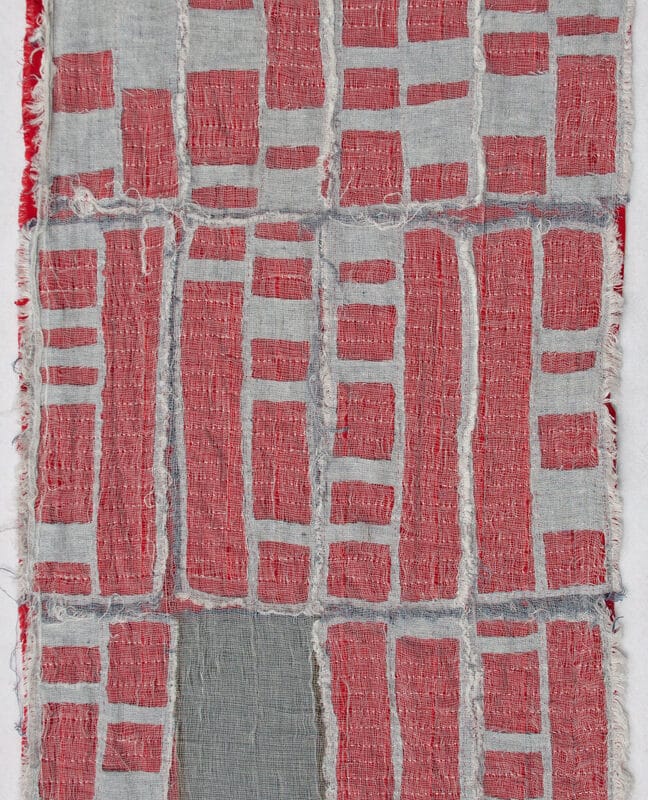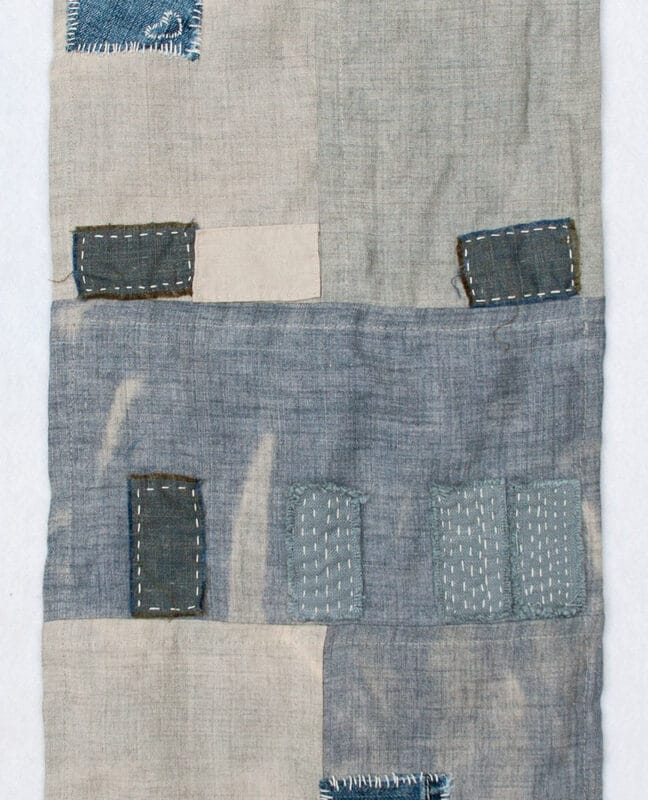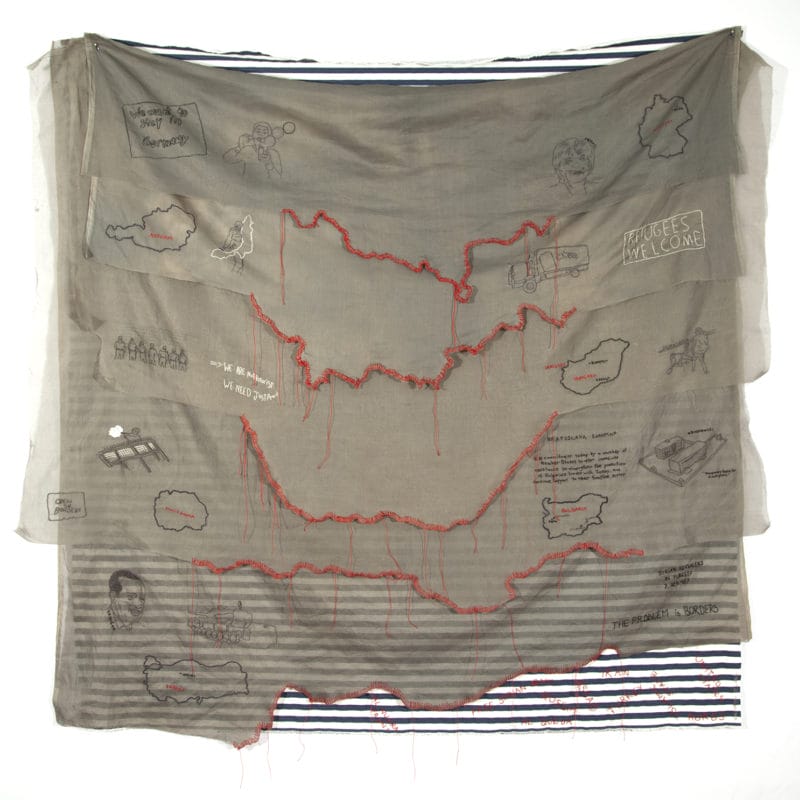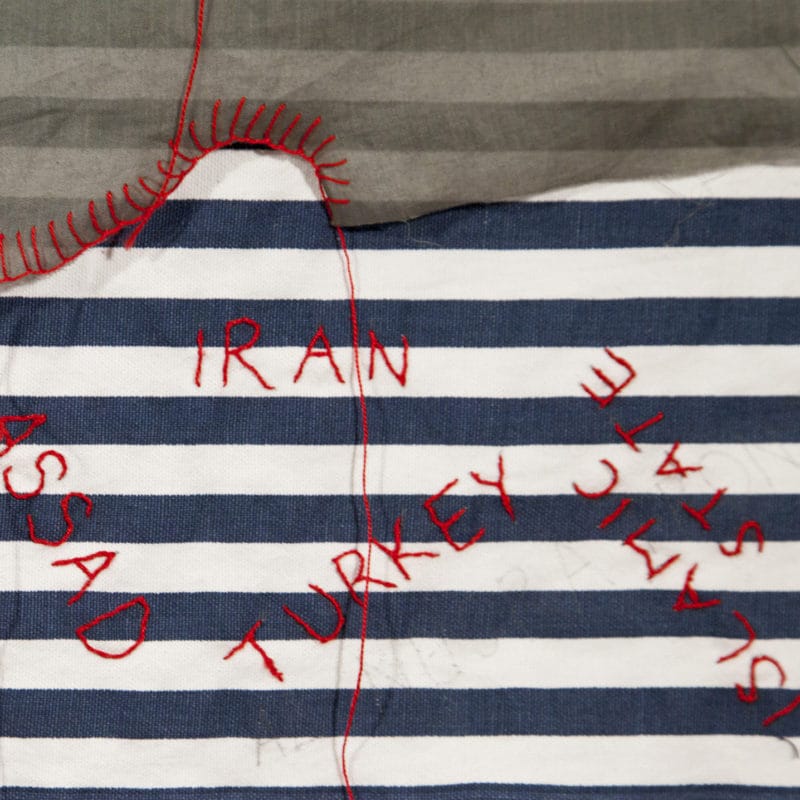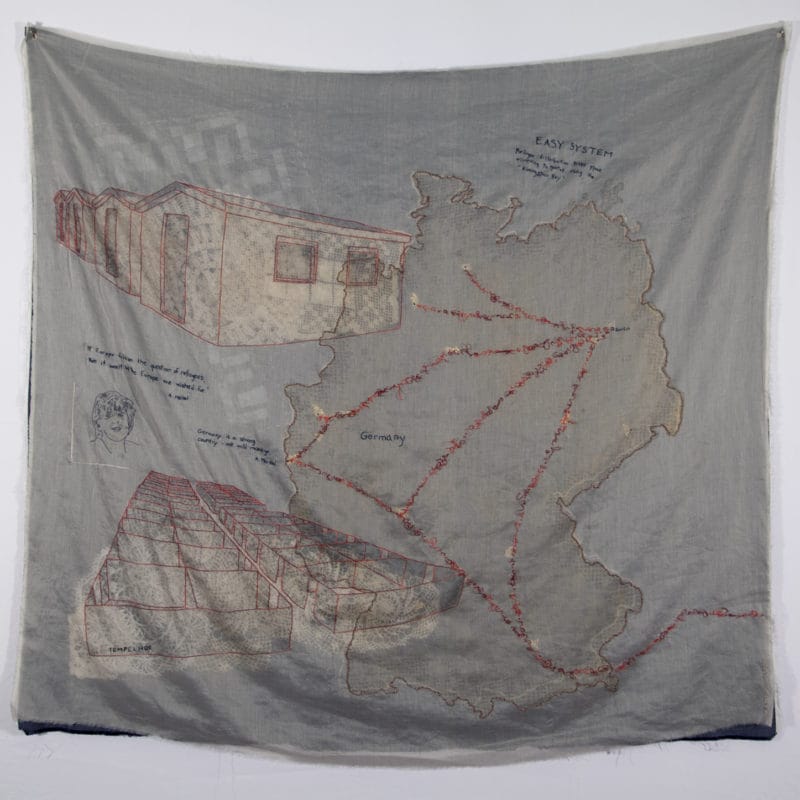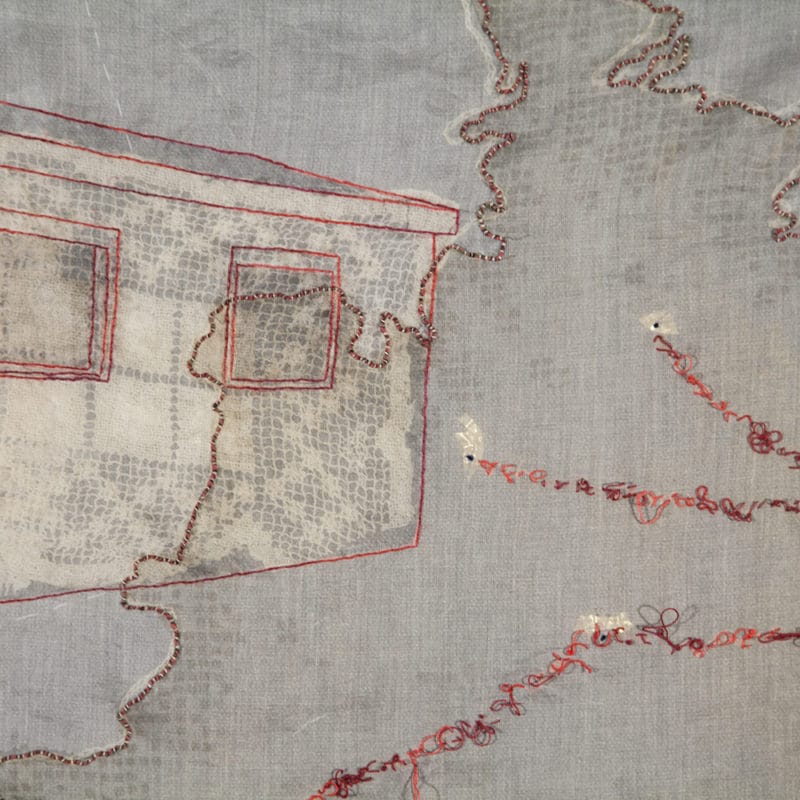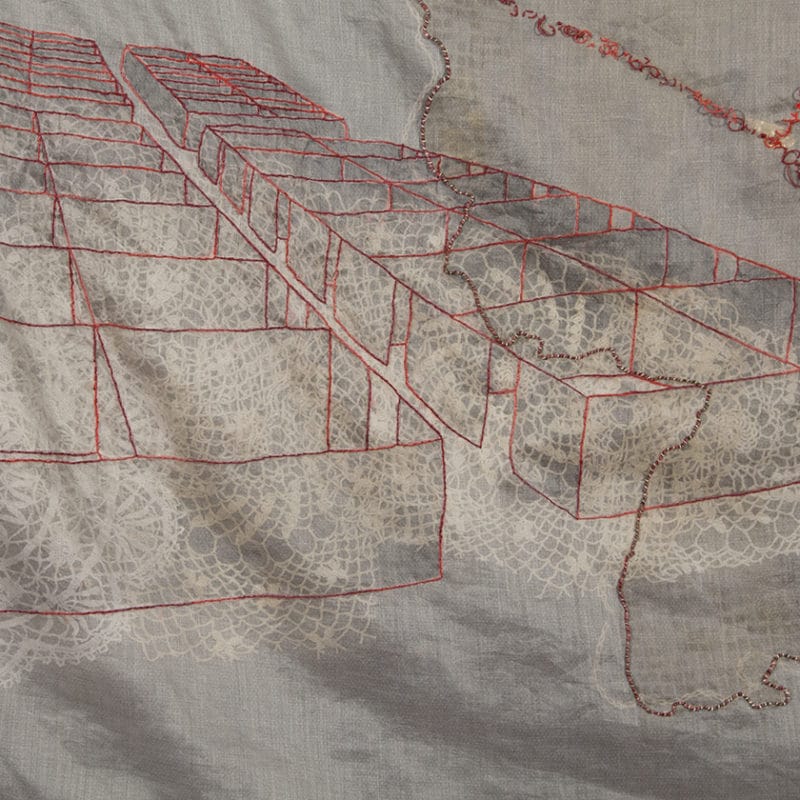Interview with Kathryn Clark
Based in San Francisco, Kathryn Clark works with the traditional textile mediums of embroidery and quilting to document global societal issues. Born and raised in the Deep South, a move to San Francisco in the 90’s posed a stark contrast to her upbringing, informing her current work. A passion for the social benefits of urban planning and a fascination with maps led her to work for Peter Calthorpe, a visionary in the field of urban planning. She left the planning field in 2004 and shifted her passion of geography and mapping into her artwork. In the past six years, her work has been widely exhibited across the U.S. and has been featured in several publications including The Craft Companion, 2016, Quilts and Human Rights, 2016 and Craft for the Modern World: The Renwick Gallery Collection, 2015 and others.
Her work is in permanent collections at the Smithsonian American Art Museum, the International Quilt Study Center & Museum, the ACLU and Michigan State University Museum.
Kathryn Clark’s recent work explores global issues ranging from the US foreclosure crisis to international border controls. Inspired by the pattern and scale of human manipulation on the planet, her work questions the long-range implications this has on our environment, society and economics. She relays these stories onto cloth, creating a historical document of our times.
link to the website:
Instagram: @kathrynclarksf
Can you tell us your story as a textile artist, how you started and why you chose the textile medium?
I was an artist for twenty years in painting and photography before I discovered textiles. I began to experiment with textiles in 2009 but couldn’t understand why I fell so hard in love with the medium, why it felt so comfortable for me. It dawned on me on Mother’s Day in 2010 when I was making a tiny weaving. My mother had been a textile artist when I was a small child but had become sick when I was eight with leukemia and had stopped making work because of it. She died when I was seventeen, so we never had a conversation about her art practice. That realization helped me understand why the medium is so grounding for me. I never looked back.
In the path you took to become a textile artist, was there an event or a person that proved to be important for your professional growth? Can you talk about it?
As I mentioned above, my mother played an important role in my choice of medium. In 2009, I was part of a mother’s artist group. We were all struggling to make art while raising children. We would meet once a month and give ourselves a theme (nature, grid, etc) with all resulting work to be 4” x 4” in size. We figured a small size would be a manageable accomplishment. It was a truly inspirational group. We made a lot of work! One of the artists, Neiley Royston, would bring embroidered pieces and textile experiments. I fell in love with her work and her materials. She taught me how to sew, what fabrics to look for, how to work and clean a sewing machine. Oddly enough, she had also lost her mother when she wasyoung so we were there for each other in other ways as well.
Kathryn, the quilts of the American tradition have always told the stories of the people who made them, dealing with current affairs, personal stories, social, political and cultural. With your artwork you honour this textile tradition. Can you tell us about your series “Foreclosure Quilt” which is an interesting document of American urban history?
Quilts have played an valuable historical role in US society, and coming from the Deep South, I was very much aware of the importance of the quilt and quilt patterns’ role in telling stories and documentation. Quilt patterns are made up of blocks. The Foreclosure series plays with this narrative by turning a traditional quilt block into a neighborhood map block. The series allowed me to combine my passions around urban design and societal issues into one body of work. Maps of the foreclosure crisis were generally behind paywalls on the internet or through intense research via local government planning websites. By mapping the foreclosure crisis into quilts, I was able to offer the public an accessible view of the crisis rarely seen before. I could also show people a way to look at the crisis through a humanistic and historical perspective, not just a statistical view. I wanted people who went through the crisis to realize they weren’t alone. It was a widespread and commonplace issue happening in America.
“Chicago Foreclosure Quilt”, 2013, 31″ x 42″ Linen, cotton and embroidery thread, copyright Kathryn Clark
How important is the experimentation of techniques and materials in your artworks?
Quilting and embroidery are very traditional mediums, going back centuries. I’m very new to textiles, only working with them for ten years.The optimal time for experimentation is when you’re still new to a medium and haven’t mastered the technique. You can see the medium through an outsider’s eyes, and really play with the tradition to accomplish the goal you want. I use my naivety as an advantage.
It’s crucial that the materials I use relate back to the meaning behind my work. Embroidery and quilting are the perfect medium for conveying a story and documentation. I also use ink and paper as those are equally common materials for telling a story.
Behind every series of your textile works, there is a careful research and historical documentation. Can you talk about it? What motivates you to deal with these topical subjects?
Most news today is read online. It’s challenging to sift through the internet and make sense of what is true and what isn’t. The waning resources for investigative journalism and the weaponizing of news is also the new normal while data is increasingly buried beneath itself just by the sheer volume of information online.
The particular stories I choose to tell are ones I feel are critically important to know about and/or have been weaponized in such a way that will harm the truth. I act as an investigative journalist by sifting through all of the above to unearth and document the facts and record them onto the permanent medium of cloth and paper. I have a duty to get this data right, I’m telling someone’s story. I need to honor them by telling the story correctly.
Among your textile works, which one represents you most and to which you feel most attached?
I’m attached to all of my work. My heart and soul is in each piece. I’m telling the story of a very specific place, of very specific people. I’m very careful about where my work travels or lives. Ultimately, I want the artworks to be in an environment that can be shared with others or live in the place they represent.
In the series “Refugees Stories”, inspired by the model of the historical tale of the Bayeux Tapestry, narrates, through embroidery, the journey of Syrian refugees into Europe. Can you tell us how this idea was born and how you developed it?
My work all begins in the same way. I pay attention to stories I feel aren’t covered well enough in the news here in the U.S. The idea to make the Refugee Stories series began in 2015, long before Trump took office and made the Syrian refugees top news in 2016-17. In 2015, few in the U.S. understood how large the crisis of the Syrian refugees was or were even aware of it. I set out to map the Syrians journey to call attention to the hardship they endured as they trekked across much of Europe. I gathered news stories, statistics and maps on the crisis, while also reading a lot on the history of Syria and surrounding countries.
Importantly, this is one of those bodies of work that takes on a completely different meaning because of time and shifting politics. By the time I finished the series, everyone knew about the refugee crisis in the U.S. The work became a flash point about borders and security in the midst ofthe US’s own growing migration issue at the Mexican border. Artwork can take on a life of its’ own long after a piece is finished. It’s important for me that the work spurs conversations and education.
What do you think is more important than the technique or the idea? What do you think determines the success or value of a work of art?
I think everyone can answer those two questions differently. For me, the idea is paramount to my work. Every single decision I make, from the smallest to the largest in the making of each piece, must relate back to the idea. For example, I made a very concious choice not to machine stitch my pieces in my Foreclosure Quilts and Refugee Stories. By hand stitching, I honor the stories of the people who’ve struggled and can spend time contemplating their stories while I stitch.
With regard to the success or value of a work of art, that’s very subjective. There are artists who consider work successful if it sells. For me, an artwork is successful if, when it leaves my hands, it conveys the intent I had hoped for it. And, as I mentioned before, sometimes art leaves your hands and it’s meaning evolves into something else that you couldn’t have foreseen. As long as it’s making someone think and question their knowledge or beliefs, that’s success to me.
“By Sea (The Aegean)”, 2016,hand embroidery and watercolor on cotton and cotton organdy. 48″ w x 62″ h, copyright Kathryn Clark
What are you working on right now? Do you want to tell us about your current textile projects?
Here in the US, if not the entire world, we’re in a state of chaos like we haven’t experienced since WWII. The very foundations of our democracy are being tested and we’re all feeling quite unmoored here while not knowing exactly what to do about it. In response, I’m reading, researching and experimenting in the studio. I’m not sure how a new series will look but it will mostly likely involve textiles and mapping, my language. However, the very idea of a static map is even questionable at this point. I also want to explore the sense of complacency that coexists during all of this chaos.
Gallery
FOTO 02”Cape Coral Foreclosure Quilt”, 2011, 30″ x 44″ Recycled bleached linen, recycled string and embroidery on voile, copyright Kathryn Clark
FOTO 02“”Cape Coral Foreclosure Quilt-detail”, 2011, 30″ x 44″ Recycled bleached linen, recycled string and embroidery on voile, copyright Kathryn Clark
FOTO 03“Detroit Foreclosure Quilt”, 22″ x 44″ Cheesecloth, linen, cotton and quilting thread, copyright Kathryn Clark
FOTO 04“Las Vegas Foreclosure Quilt”, 2011, 12″ x 36″ Recycled denim, wool, yarn and embroidery thread on bleached linen, copyright Kathryn Clark.
FOTO 05”By Land”, 2017,hand embroidery on cotton organdy. 60″ w x 58″ h, copyright Kathryn Clark
FOTO 06”By Land-detail”, 2017, hand embroidery on cotton organdy. 60″ w x 58″ h, copyright Kathryn Clark
FOTO 07”By Land-detail”, 2017, hand embroidery on cotton organdy. 60″ w x 58″ h, copyright Kathryn Clark
FOTO 08 “New Home”, 2017, hand embroidery and watercolor on cotton organdy. 56″ w x 56″ h, copyright Kathryn Clark
FOTO 09 “New Home-detail”, 2017, hand embroidery and watercolor on cotton organdy. 56″ w x 56″ h, copyright Kathryn Clark
FOTO 10 “New Home-detail”, 2017, hand embroidery and watercolor on cotton organdy. 56″ w x 56″ h, copyright Kathryn Clark
